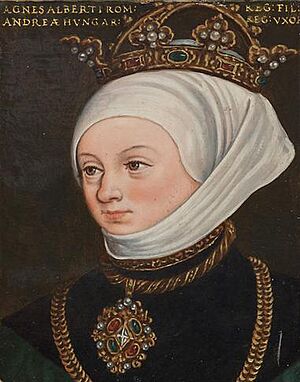Agnes of Austria (1281–1364) facts for kids
Quick facts for kids Agnes of Austria |
|
|---|---|
 |
|
| Queen consort of Hungary | |
| Tenure | 1296–1301 |
| Born | 18 May 1281 |
| Died | 10 June 1364 (aged 83) Königsfelden, County of Tyrol, Holy Roman Empire |
| Burial | Königsfelden Monastery, County of Tyrol, Holy Roman Empire |
| Spouse | Andrew III of Hungary |
| House | Habsburg (by birth) Árpád (by marriage) |
| Father | Albert I of Germany |
| Mother | Elisabeth of Tirol |
Agnes of Austria (born May 18, 1281 – died June 10, 1364) was an important princess from the House of Habsburg. She became the Queen of Hungary when she married Andrew III of Hungary. Agnes was known for her modesty and her role as a peacemaker in later life.
Agnes's Life and Royal Role
Agnes was the daughter of Albert I of Germany and his wife Elisabeth of Tirol. Her family, the House of Habsburg, was very powerful in Europe. She became Queen of Hungary through her marriage, which was a common way for royal families to form alliances.
Becoming Queen of Hungary
On February 13, 1296, Agnes married Andrew III of Hungary in Vienna. This marriage helped Andrew gain support from Agnes's father. With this help, Andrew was able to stop a rebellion led by Miklós Kőszegi and Máté Csák III. He also took control of the castles of Kőszeg and Pozsony.
Agnes was not a fan of noisy tournaments. Instead, she preferred listening to sermons. People admired her for her modesty. She was quite small and sometimes wore dresses her sisters no longer needed.
King Andrew III died on January 14, 1301, in Buda. His death meant the end of the male line of the Árpád dynasty. A historian from that time, Stephen Ákos, called Andrew "the last golden twig of the Árpáds."
Her Later Years
When Andrew III died, Agnes was only 19 years old. She was a widow and had no children to continue the Árpád family line. Even though she was young enough to remarry and have children, she never did.
Agnes became a supporter of Königsfelden Monastery in the County of Tyrol. Her mother had founded this monastery to honor her late husband. Agnes moved to a small house near the monastery. She brought her stepdaughter, Elizabeth, with her. Elizabeth was supposed to marry Wenceslaus III of Bohemia. However, that wedding never happened. Wenceslaus married someone else, and Elizabeth became a Dominican nun at a nearby monastery. She became known for her holiness.
Agnes was seen as a very religious and good person. Because of her excellent reputation, people often asked her to help settle disagreements. In 1333, she helped create a peace treaty between Austria and several Swiss towns during a conflict. In 1351, she solved a dispute between Basel and Bremen. In the same year, she also helped Albert II, Duke of Austria and the Swiss Confederacy resolve their differences. Her brothers often visited her at Königsfelden to ask for her advice.
Agnes passed away on June 10, 1364, at Königsfelden. She was buried in the nuns' cemetery at Königsfelden Monastery.
Images for kids






